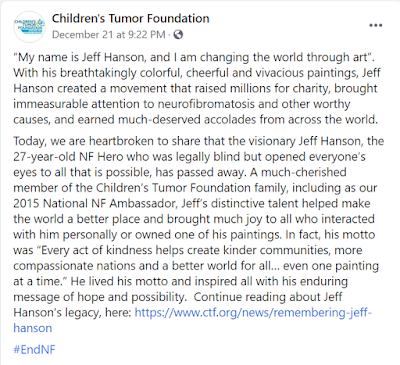|
12/18/2020 |
Run |
5.0 mi |
49:03 |
|
12/20/2020 |
Run |
13.2 mi |
2:12:40 |
|
12/21/2020 |
Run |
4.4 mi |
42:52 |
|
12/23/2020 |
Run |
5.0 mi |
47:53 |
|
12/24/2020 |
Run |
5.0 mi |
47:30 |
Every year for the past seven I’ve run 1000 miles per year. This year I lost several weeks with a broken heel, but since I swam almost 60 miles this year, I figure I only have to make it to 940 miles running to keep the streak going. I’m at 923.3 miles as of today—only 17.1 to go before the end of the year. Barring any surprises I should make it!
Jane Update:
Two days before Christmas Jane had a PET scan to further evaluate her abdominal tumor, which had grown more than expected in the past 6 months.
We arrived at the hospital just after 9 am. Jane had been instructed not to eat or drink anything the morning of the test. Once we were in an exam room, the first thing that happened was Jane had a radioactive tracer infused into a vein in her arm. The tracer is a chemical similar to glucose (a type of sugar) with a radioactive bit attached. Since tumor and cancer cells are more active than most cells, they use up more glucose than regular cells (in medical terms, they are more “metabolically active”). Tumor and cancer cells will also take up more of the tracer than regular cells, so by looking for areas of the body where the tracer is concentrated, a PET scan can identify cancers.
 |
| Jane's radioactive now, just like Spider-Man |
Jane and I
joked that the radioactivity made her like Spider-Man. The technologist tending to Jane said she
couldn’t promise that Jane would develop any superpowers, but we agreed that she
does have a certain glow about her :)
After the infusion we had to wait an hour for the tracer to be absorbed by her body. During that time Jane was given a large cup of oral contrast to drink (to help the radiologists see her intestines). Since the contrast is not particularly palatable, the technologist said she mixes in some Crystal Light powder to make it taste better! Jane was allowed to choose from various flavors and picked Peach Tea.
Finally came the scan, which itself took about a half hour. The PET scanner is not noisy like an MRI, so it was a bit more peaceful.
 |
| Puppy by her side, as always |
While we haven’t yet been able to speak with NIH regarding
the results, we were given the preliminary report. All of Jane’s tumors lit up, as expected,
since most tumors are somewhat metabolically active. NIH had said they would be concerned if the
metabolic activity (“SUV”) of Jane’s abdominal tumor was a value over 5. (Normal is zero.) I am happy to say the maximum SUV was 3.8!
So now we wait for the interpretation from NIH. This scan was to determine if Jane needed surgery
ASAP because of a malignancy, which thankfully does not yet appear to be the
case. We will be meeting (virtually) with
the NIH team neurosurgeon and urologist in early January to discuss timing of
the surgery. Ideally, we would plan
surgery during a school break in either the spring or summer, but also have to
take into account the status of the pandemic.
The tumor is pressing on her kidney and the bigger it gets the more
complicated the surgery will be. (If it
hadn’t been for the pandemic, Jane would have had this darn thing removed 6
months ago!)
NF Update:
While this
week brought good news for our family, it was not so for another NF family.
Jeff
Hanson was a brilliant artist,
philanthropist, and NF Hero. I’ve sent many of you notecards with his brightly
colored artwork. He passed away this
week due to complications of neurofibromatosis.
NF is Not Fair.
Here are some links to learn more about Jeff and his art:


















